金融市场学第四版1、2章英文讲义
- 格式:doc
- 大小:136.44 KB
- 文档页数:9
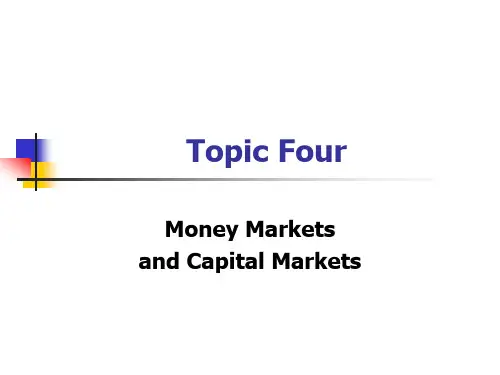
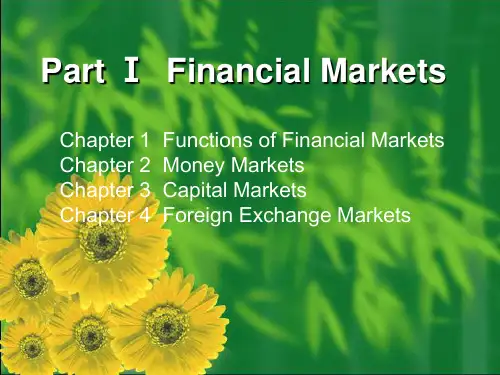

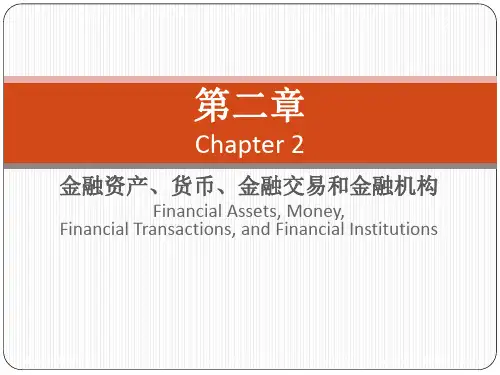
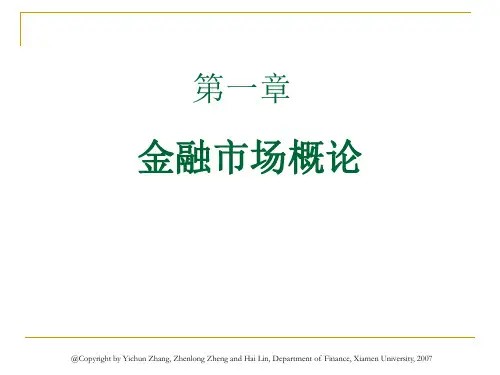
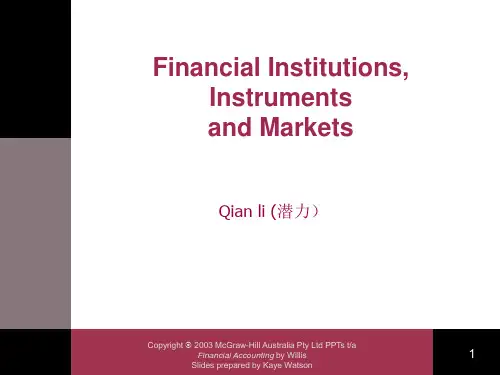


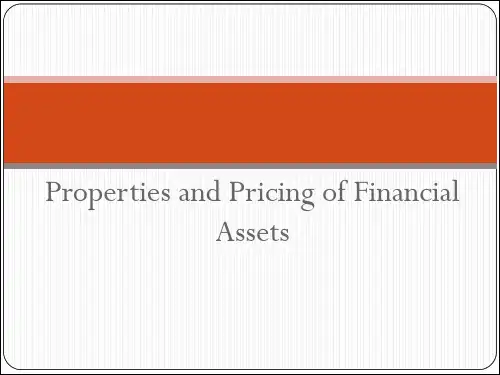
Chapter 1 IntroductionTypes of AssetsTangible AssetsValue is based on physical propertiesExamples include buildings, land, machineryIntangible AssetsClaim to future incomeExamples include various types of financial assetsTypes of Financial AssetsBank loansGovernment bondsCorporate bondsMunicipal bondsForeign bondCommon stockPreferred stockForeign stockDebt vs. EquityDebt InstrumentsFixed dollar paymentsExamples include loans, bondsEquity ClaimsDollar payment is based on earningsResidual claimsExamples include common stock, partnership sharePrice of Financial Asset and RiskThe price or value of a financial asset is equal to the present value of all expected future cash flows.Expected rate of returnRisk of expected cash flow(pp3,give present value)Types of Investment RisksPurchasing power risk or inflation riskDefault or credit riskExchange rate or currency riskRole of Financial AssetsTransfer funds from surplus units to deficit units.Transfer funds so as to redistribute unavoidable risk associated with cash flows generated from both tangible and intangible assets.(pp5:examples analysis)Key Points You Should UnderstandDifference between tangible and financial assetsDifference between debt and equityCash flow of a financial assetThree types of risks associated with financial assetTwo principal economic functions of financial assetsRole of Financial MarketsDetermine price or required rate of return of asset.Provide liquidity.Reduce transactions costs, which consists of search costs and information costs.(contrast by Chinese textbook)Classification of Financial MarketsDebt vs. equity marketsMoney market vs. capital marketPrimary vs. secondary marketCash or spot vs. derivatives marketAuction vs. over-the-counter vs. intermediated marketFinancial Market ParticipantsHouseholdsBusiness unitsFederal, state, and local governmentsGovernment agenciesSupranationalsRegulatorsKey Points You Should UnderstandThree economic functions of financial marketsWays that financial markets can be classifiedMarket participantsGlobalization of Financial MarketsDeregulation or liberalization of financial marketsTechnological advancesIncreased institutionalizationClassification of Global Financial MarketsMotivation for Using Foreign Markets and EuromarketsLimited fund availability in internal marketReduced cost of fundsDiversifying funding sourcesDerivatives MarketFutures/forward contracts are obligations that must be fulfilled at maturity.Options contracts are rights, not obligations, to either buy (call) or sell (put) the underlying financial instrument.(call option ;put option)Role of Derivative InstrumentsProtect against different types of investment risks, such as purchasing power risk, interest rate risk, exchange rate risk.Advantages:Lower transactions costsFaster to carry out transactionGreater liquidity(Examples.see page 9)Key Points You Should UnderstandThree major factors that have integrated financial marketsInstitutionalization of financial marketsInternal and external marketsMotive to raise money outside of domestic marketTwo basic types of derivativesPrincipal economic role of derivativesPotential uses of derivativesTypes of RegulationDisclosure regulation (asymmetric information & agency problem)Financial activity regulation (internal transaction & minimization of investors’tricked risk) Regulation of financial institution (the key role of financial institution in real world)Regulation of foreign participationRegulation in the United StatesReasons for regulationStock market crash of 1929Great Depression of 1930sRegulation primarily by SEC, CFTC, Treasury, and Federal Reserve“Blueprint for Regulatory Reform”Split regulation by functionsMarket stability regulatorPrudential regulatorBusiness conduct regulatorKey Points You Should UnderstandExplanation for the existence of regulationGoals sought in regulationMajor forms of regulation“Blueprint for Regulatory Reform”All rights reserved. No part of this publication may be reproduced, stored in a retrieval system, or transmitted, in any form or by any means, electronic, mechanical, photocopying, recording, or otherwise, without the prior written permission of the publisher. Printed in the United States of America.Chapter 2 Financial Institutions, Financial Intermediaries and Asset Management FirmsServices of Financial InstitutionsTransforming Financial AssetsExchanging Financial Assets on Behalf of CustomersExchanging Financial Assets for Own AccountAssisting in the Creation of Financial AssetsProviding Investment AdviceManaging PortfoliosRole of Financial IntermediariesTransfer of funds from savers to investorsTypes of InvestmentsDirect InvestmentFor example, purchasing a portfolio of stocks and bondsIndirect InvestmentFor example, purchasing an equity claim issued by an investment companyRole of Financial IntermediariesProviding Maturity IntermediationReducing Risk Through DiversificationReducing Costs of Contracting and Information ProcessingProviding a Payments MechanismRole of Financial IntermediariesProviding Maturity IntermediationReducing Risk via DiversificationReducing Costs of Contracting and Information ProcessingProviding a Payments MechanismAsset/Liability ManagementSpread and Non-Spread BusinessesNature of LiabilitiesAmount of cash outlayTiming of cash outlayLiquidity ConcernsRegulations and TaxationNature of Liabilities of Financial InstitutionsConcerns of RegulatorsCredit RiskSettlement RiskCounterparty RiskLiquidity RiskMarket Liquidity RiskFunding Liquidity RiskMarket RiskOperational RiskAsset Management FirmsRanked by assets under managementLiability Type Amount of Cash Outlay Timing of Cash Outlay Type IKnown Known Type IIKnown Uncertain Type IIIUncertain Known Type IVUncertainUncertainFees and CompensationFee structureFee based on assets under management Performance-based feeTypes of Funds ManagedRegulated investment companiesInsurance company fundsSeparately managed accountsPension fundsHedge fundsHedge FundsNo single definition of hedge fundGeorge SorosPresident’s Working Group on Financial Markets U.K. Financial Services AutorityHedge Fund Characteristics“Hedge”is misleadingWide range of trading strategiesLeverage, short selling, arbitrage, risk control Operate in all financial marketsFocus on absolute returnsLastly, funds cater to sophisticated investorsTypes of Hedge FundMarket directional hedge fundCorporate restructuring hedge fund Convergence trading hedge fundOpportunistic hedge fundConcerns with Hedge FundHedge funds provide market benefitsLiquidityMarket pricing efficiencyHowever, there are concernsSystem riskLong-Term Capital ManagementBear StearnsMarket meltdown of 2008All rights reserved. No part of this publication may be reproduced, stored in a retrieval system, or transmitted, in any form or by any means, electronic, mechanical, photocopying, recording, or otherwise, without the prior written permission of the publisher. Printed in the United States of America.。